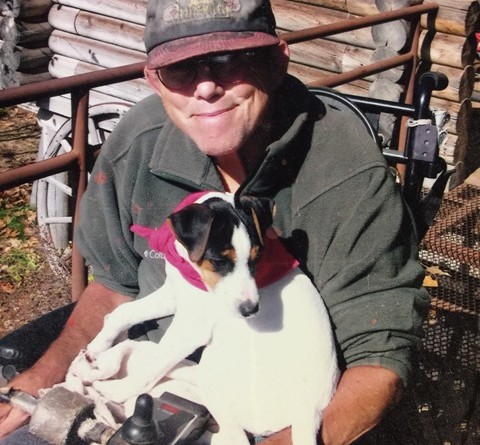Dogs & Depression
By Rachel Menke
Do dogs get depressed? I am personally and professionally familiar with depression in humans. I had no firsthand experience of depression in dogs, however, until our 12-year old Jack Russell Terrier, Chaco, spent the latter part of 2016 in a major funk.
Chaco’s depression started on May 23, 2016 when his most beloved companion, Pat (my late father-in-law) died. Pat was not Chaco’s owner per se, but for the last six years of Pat’s life we lived with him. Yes, Chaco loves my husband, daughter, and me — his rightful owners — but Pat was his person. There was something special about their relationship. There was something special about Pat.
Pat was crippled, physically ravaged by the effects of living with the ruthless disease of Multiple Sclerosis for forty years. By the time we moved in, Pat’s body was paralyzed from the neck down. He was confined to a motorized, head-controlled wheelchair and was dependent on others for his most basic needs.
Picturing that scenario makes most people pity anyone unlucky enough to land that fate. However, anyone who actually knew Pat, or even had a few minutes in conversation with him, didn’t feel sorry for the guy. In fact, most of us were humbled by his genuine gratitude, resolve and strength. And he was not just thankful to simply be alive. He lived his life to the fullest — yes, even a quadriplegic can have a good quality of life.
Pat lived his life slowly and deliberately. Years ago, he resolved to be consciously patient because the alternative in his situation would’ve been anger and frustration. Pat’s pace of life was similar to that of an older dog. One thing that Pat was able to do independently until his death was go outside for a “walk.” He went out every day, rain or shine.
He spent hours outside, often taking two or more walks in a day. This was a gift to Chaco who had moved from a city where he spent most days inside and alone while we were at work. They would stroll and scout out the neighborhood. Chaco would stop to sniff something, Pat would stop to contemplate clouds, look at neighbor’s flowers and trees or admire the spectacular view of Mt. Sopris.
Before leaving the house, Pat’s caregiver would place a pile of dog treats in his lap. Half were for the neighbor dogs, and half for Chaco. Pat counted dogs among his friends, just as his did with humans. Between daily walks, Chaco spent his time inside on Pat’s lap while he watched movies, listened to BBC on the radio or studied maps of the world. Chaco also loved to lie in bed with Pat, burrowing under the covers or snuggling up in the crook of his legs.
Chaco was lying in bed with him when Pat took his final breath. That was the start of a dark time for Chaco. If dogs could cry, he would have shed many tears during those weeks after Pat’s death, just like we all did.
We would find Chaco moping around the house, lying in a chair instead of Pat’s lap, and occasionally letting out an audible sigh. He didn’t want to eat. He didn’t want to go out for walks or play fetch in the yard.
Around this same time, I was also depressed. In addition to feeling the grief of Pat’s death, I was working in a job that I had grown to resent and my marriage was rocky, to say the least. This was not the first time I had struggled with depression– there was an episode in college, and I had major postpartum depression and anxiety in 2012. However, this time was different for me. I had more insight, a good counselor, supportive friends and the right medications. I also had Chaco.
Seeing him so gloomy was like looking at myself. Feeling like I wanted to help him, but not sure exactly how made me realize that my friends and family felt the same way about me. Finally, I was able to open up and be vulnerable.
Last August, I quit the job that I felt stuck in and began working in Hospice & Palliative Care. It is rewarding work. I have learned so much about death, grief and depression doing this work, but never as much as I learned from Pat’s death and my dog, Chaco.
Rachel has been a RN for 15 years and a nurse practitioner for 7 of them. Now she loves taking care of babies and old people best! In hospice, however, she is a midwife of death, not birth. Outside of taking care of her family and patients, she takes care of herself by practicing yoga, painting, gardening and lots of reading. She used to be an avid runner, but now she is an avid dog walker.

